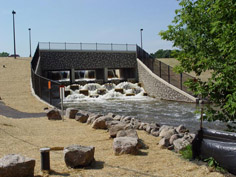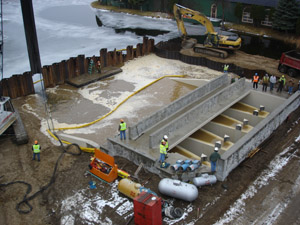Latest News
Renovating the New London Dam

By Marty Weber, Stanley Consultants
The New London Dam forms Lake Monongalia -- the very heart and soul of the City of New London, Minnesota.
In 2008, Stanley Consultants began to provide the city with dam engineering design, coupled with insightful constructability planning, which made the development of a new dam within a very small site possible. The new dam needed to meet the Department of Natural Resources (DNR) goals of rehabilitating a high-hazard dam, improving safety, alleviating flood concerns, and reducing operational aspects.
Construction took place with no change to the normal levels of the popular lake. The new dam is now on par with modern design standards, requires minimal manpower to operate, is visually appealing, and is a recreational attraction for the town.
The New London Dam had been on the DNR's wish-list for renovation since the 1990s due to deficiencies including substandard embankment stability, undesirable seepage, and insufficient spillway capacity. In addition, the dam’s outlet works, which consisted of electrically-operated vertical slide gates, were not reliable and put strain on the staff responsible for its operation.
Failure of the dam would likely have led to loss of life, and would undoubtedly have led to severe economic impacts due to residential and commercial property damage. Simply removing the dam was not an option, as this would have reduced Lake Monongalia to mud flats and eliminated what had been the identity of the city for about 150 years.
In 1860, the Swedish trapper Louis Larson was exploring new lands when he found a waterfall on a small river in central Minnesota. Being not only a trapper but also an entrepreneur, Larson built a timber-crib dam and sawmill in 1862.
After war broke out, settlers were driven from the area. Upon return, Larson had to reconstruct the dam and sawmill. He also constructed a new gristmill. The mills thrived and the lumber and flour they produced attracted settlers for miles.
The town of New London was established and served as the Monongalia County Seat until 1870. For 70 years, the New London Mill prospered. In 1938, the State of Minnesota bought the dam and mill, and, in 1940, the United States Fish and Wildlife Service built a national fish hatchery there. The dam has since been rebuilt several times, and the mill and hatchery have been removed.

Labyrinth weirs have been used as dam spillways for many years, but are relatively rare, and, to our knowledge, have never before been used in Minnesota. The use of a labyrinth weir for the new dam’s spillway made the most efficient use of the available space, which reduced construction costs. Furthermore, it eliminated the need for a mechanical gate system, which made fabrication unnecessary and reduced operations and maintenance costs for the life of the project.
Applying the labyrinth weir to the dam increased spillway capacity to safely accommodate the inflow design flood, minimized disturbance to community by limiting construction to the existing dam’s footprint, and maintained historic Lake Monongalia water levels and downstream river flows.
The switchover from passing water through the old outlet works to the new spillway took place in December 2010. Since then, the Lake Monongalia water level has remained similar to its historical levels and is well received by the public.
City officials have noted a significant increase in recreational use of the dam, especially the canoe/kayak portage route. In addition, several other amenities were included in the reconstruction design. And the portage route, walkways, and parking were designed in accordance with Americans with Disabilities Act (ADA) requirements.
For more information about the project or about Stanley Consultants, please contact Marty Weber at (952) 738-4332 or WeberMartin@StanleyGroup.com.
What's New
-

Young Professionals Spotlight
March 25, 2024
-
Apply for the Young Professionals Stipend: Attend PWX Atlanta
February 23, 2024
-

2024 APWA-MN President's Message
January 25, 2024



